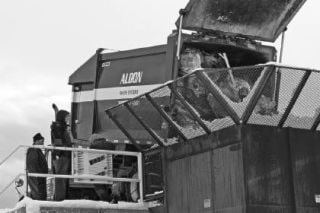Salmon Arm’s switch to curbside collection of garbage and recyclables has been a learning process for the public as much as it has been for the Columbia Shuswap Regional District.
Since the beginning of January, when the program began, staff at the regional district and the City of Salmon Arm have received many calls relating to the program. A good portion of these have been about the the recycling component.
Carmen Fennell, waste reduction facilitator with the CSRD, says the majority of the calls she’s received haven’t exactly been complementary. But she empathizes with people’s frustration and asks that residents have patience, as it’s a learning process for everyone involved.
“We’re not typically in the hauling business for garbage collection, so it’s a new concept for us also,” says Fennell.
That said, Fennell and the CSRD staff have been busy updating their website, endeavoring to have clear, concise information available for the public.
The latest addition to the CSRD website (http://www.csrd.bc.ca), on the garbage and recycling page, is a frequently asked questions sheet that elaborates not only on what goes in the blue bags, but why, and how it’s all sorted and dealt with. For example, this section explains that milk jugs (plastic #2) can be included recycled through the curbside program, though the CSRD encourages their return to a recycling depot. The reason being is that the Dairy Council of BC pays to recycle the bottles and, “by placing these materials in your clear/blue bag, you are in effect subsidizing of an industry led program.”
Why bags instead of blue bins is another question asked often. Fennell says this decision goes back to the creation of the CSRD’s solid waste management plan. During this a number of options were looked at and reduced to two: automated pickup (bin system) and the blue bag system. It was determined by the public that the bag system would the more cost-effective option. Fennell notes that switching to the automated system in the Central Okanagan Regional District has seen an increase in the contamination rate of recyclables as drivers are unable to see what they’re picking up.
“Not only is (the bag system) a less expensive option, it’s also a way for drivers to see pretty quickly if there’s an engine part in that bag or potted plants, which is a common thing that falls out on their recycling line,” says Fennell.
Over at the Salmon Arm landfill, the CSRD’s recyclable reload station is slowly seeing more use as residents get accustomed to the program.
“I know just driving to work in my neighbourhood, Tuesday is my pickup day, and probably every third or fourth house had their garbage out. Today was better,” CSRD waste management co-ordinator Ben Van Nostrand commented last week.
The reload station, which includes a recyclable compactor, was established after Salmon Arm agreed to come onboard with the program. Van Nostrand expects the $200,000 facility (paid by CSRD member municipalities through taxation), will get busier as the curbside program increasingly diverts recyclables from the co-existing green bin program.
“I suspect the bin program, the tonnages should drop off as people divert their materials and put it to the curb rather than taking it to the depots,” says Van Nostrand.
Fennell welcomes any input (250-832-8194) that might further aid or ease the user experience.
